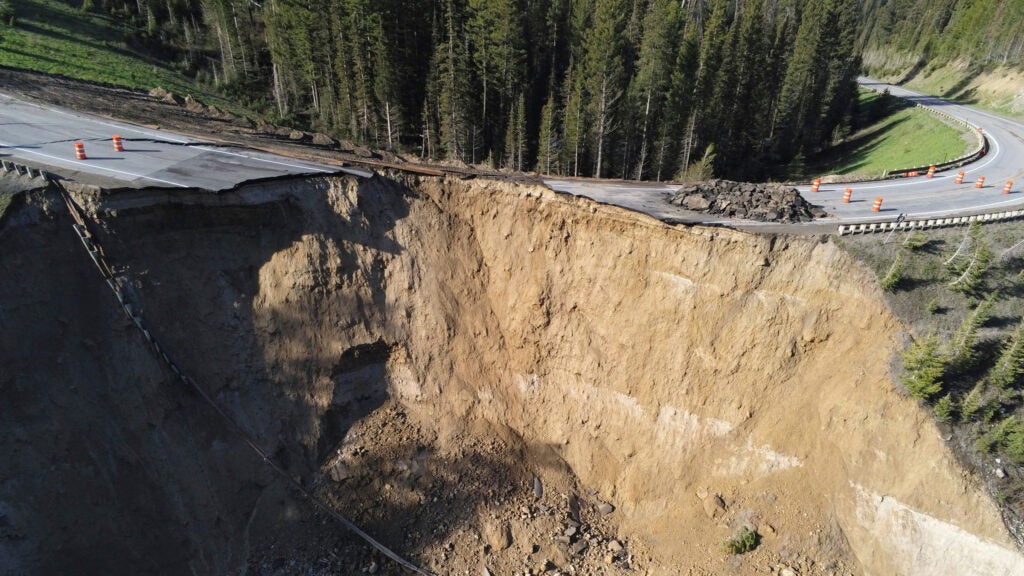No products in the cart.
Outdoor Adventure
Check Out These Photos of the Teton Pass Collapse
Heading out the door? Read this article on the Outside app available now on iOS devices for members!
Download the app.
What started with a small crack in the road last Thursday developed into a full-blown disaster. A large section of Wyoming Highway 22—better known as the Teton Pass—collapsed on Friday, June 7, following a series of mudslides that culminated in what officials are calling a “catastrophic failure.” In the wake of the collapse, Wyoming Gov. Mark Gordon issued a statewide declaration of emergency. The pass connected Jackson, Wyoming to its bedroom community Victor, Idaho, leaving workers and tourists facing a sizable detour.
Winding for approximately 17 miles through the rugged peaks that divide Idaho’s Teton Valley from the Wyoming tourist hotspot of Jackson, Teton Pass is the only cross-state route for miles in either direction. Driving between the two bordering towns normally takes 30 minutes or so. Without the pass, the journey is nearly two hours and requires a circuitous 85-mile detour south to Alpine and the Snake River, along U.S. Highways 26 and 89.
Images of the destroyed roadway flooded social media this week. Officials have not provided a timeline for opening the thoroughfare.
TETON PASS COLLAPSE: Drone video from Wyoming Department of Transportation shows extent of damage in Teton Pass road collapse.
DETAILS: https://t.co/SfKfVeK9EQ pic.twitter.com/bcL0jh2JDH
— KUTV2news (@KUTV2News) June 10, 2024
In the summer high season, the Teton Pass can see as many as 15,000 cars per day, primarily tourists heading to outdoor hotspots like Yellowstone and Grand Teton National Park. But the closure presents more than an annoyance for summer roadtrippers. Per the U.S. Census Bureau, over 3,000 locals use this highway to commute from Idaho to Wyoming for work each day. The closure will have a dramatic impact on Wyoming’s tourism industry, a key income generator in summer months. From 2022 to 2023, over $1.7 billion in revenue was generated by tourism in Teton County.
Over the weekend, dramatic photos and videos of the collapsed highway flooded social media. Aerial drone footage captures the full scope of the disaster—the roadway collapsed more than 20 feet to the ground below.
This is wild! “Catastrophic failure of Teton Pass between Jackson Hole and Victor Idaho. It is a key artery for commuters and commerce. Going to be a rough summer for employees and businesses” pic.twitter.com/vVEMJwy88D
— Heidi Hatch KUTV (@tvheidihatch) June 8, 2024
The initial crack in the highway led to a motorcycle crash along on Thursday morning. A motorcyclist was reportedly traveling west on the pass, at around 25 to 30 mph, when the road abruptly split and and dropped half-a-foot beneath him. The rider, in his early 60s, dumped his touring motorcycle but wasn’t seriously injured.
The resulting crack was up to eight inches deep in places, and spanned both lanes of travel at a hairpin turn. The road closed for several hours as crews worked to inspect and patch the rift. The road reopened Thursday night, but relief was only temporary, as shortly after 4:00 A.M. Friday, mudslides a few miles east sent crews scrambling to repair the road, closing the pass yet again. Later that evening, the rift back at mile marker 12.8 expanded dramatically—elevating into a full-blown landslide—with a large portion of the alpine highway plummeting into the ravine below.
An important update: #TetonPass road closure continues, interim detour planned #wyoroad https://t.co/6sFfhDxeBl
Video shows a before and after view of the landslide area. (before view is from 2023)Reporters: you can access our media kit here: https://t.co/T5EJIayMaH pic.twitter.com/45m4KrNF6I
— Wyoming Department of Transportation (@WYDOTNews) June 10, 2024
A June 10 press release by the Wyoming Department of Transportation (WYDOT) said geologists and engineers were evaluating the situation and developing a plan to rebuild the road, but that, “there is no current estimated timeline for that construction.” In the meantime, engineers are working on a temporary detour route through the Caribou-Targhee National Forest, which will likely entail restrictions on vehicle weight and width. Even this, however, will take a few weeks to open.
“We understand this highway is a lifeline for commuters, deliveries, medical care access and tourism, especially with limited alternatives and the summer season upon us,” WYDOT wrote on Facebook. “WYDOT engineers, surveyors and geologists mobilized quickly to try to maintain highway viability as long as possible, but catastrophic failure could not be avoided.

